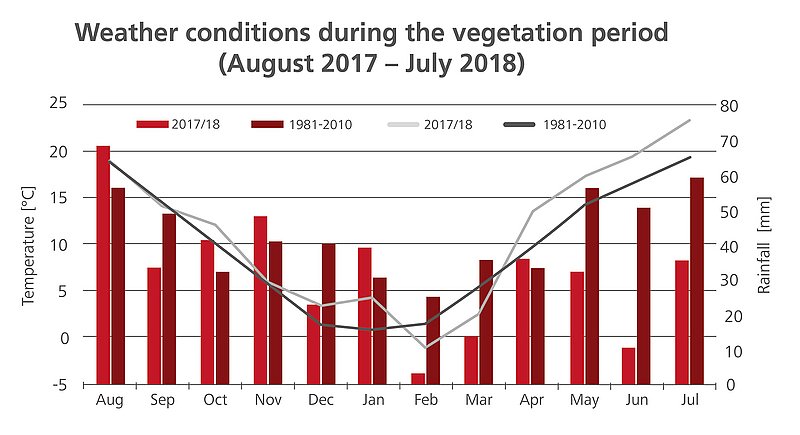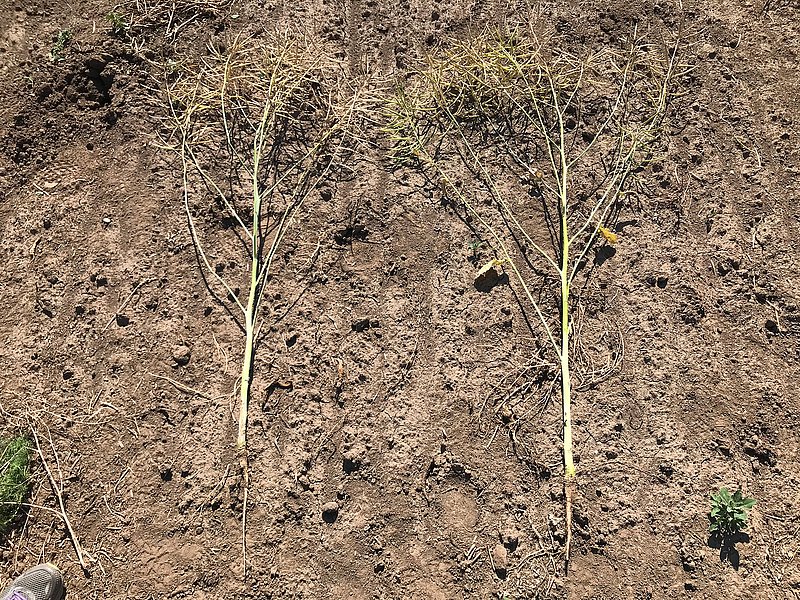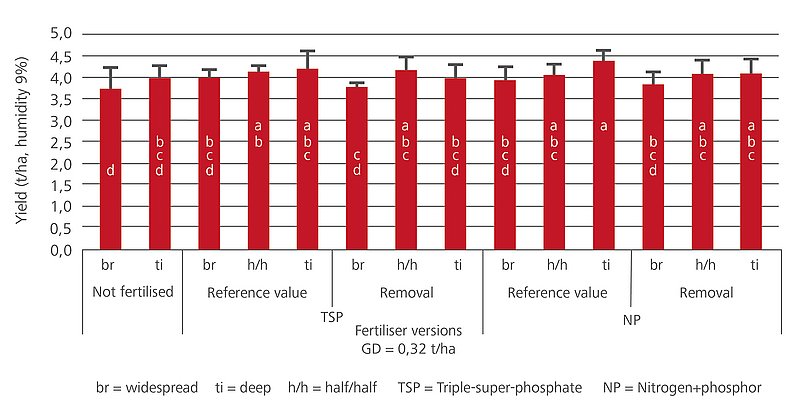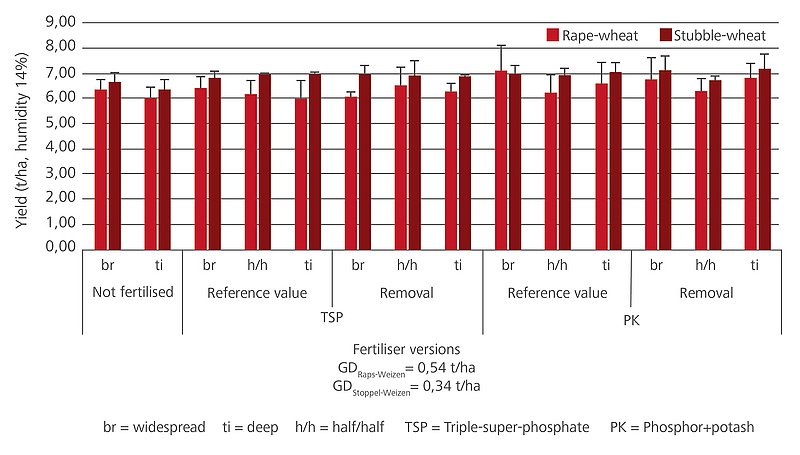Joint project with the DLG
The Federal Agency for Agriculture and Food (BLE) sponsors a three-year joint project of HORSCH and the DLG (German Agricultural Society) with the title “Development of innovative P-fertilisation systems to increase P-efficiency and reduce negative environmental effects”. terraHORSCH presents the intermediate results.
The DLG and HORSCH co-operate in the joint project that is sponsored by the BLE “Development of innovative P-fertilisation systems to increase P-efficiency and reduce negative environmental effects”. The project that will last for three years started in 2016, so this is the last test year. The objective, the setting and the results of the second test year have already been discussed in terraHORSCH 16/2018.

In the second test year, similar to season 2016/17, with approx. 380 mm/m² from August 2017 until July 2018 it was not possible to achieve a sufficient water supply. With an average rainfall of 511 mm (1981-2010) the site in Bernburg is rather dry. In 2016/17 and especially in 2017/18 this amount even was considerably lower. At the site with excellent loess-black earth soils with an average of 85 soil points and a useful field capacity of 250 mm the yields settle down at an average level despite the long draught in spring and summer 2018.
The field test for the test year 2017/18 started on the 1st of September 2017 with the winter rape seed. The field had already been prepared for the seed – the previous crop was winter wheat – and was then loosened with the HORSCH Focus TD at about 22 cm and provided with the respective amounts of fertiliser.
The winter wheat blocks were sown on 28th and 29th of September 2017 in rather wet conditions. The previous crop of the first block was winter rape and of the second block it was winter wheat. We can compare the sectors rape-wheat and stubble-wheat and, thus, are able to test the previous crop effects, too.
Sowing was also carried out with the HORSCH Focus TD. The fertiliser tests were laid according to the same pattern as for winter rape. The row spacing of the seed coulters is divided in half to 15 cm for sowing cereals. This means: Two seed coulters respectively follow one loosening coulter and are mounted at the left and the right side of the loosened area.
Results harvest 2018
The experiences from the first two test years partly show significant differences between the versions.
Winter rape:
The rating in autumn 2017 already showed clear differences in the root collar diameter and the surface growth. The fertilised versions, especially the version where NP fertiliser (DAP 17/46) was used, stood out positively due to a better pre-winter development.
In spring, the differences were particularly obvious at the time when the flowering started. The flowering of the not fertilised versions started considerably earlier compared to the differently fertilised versions. This surely is mainly due to the very dry spring 2018.
At the pre-harvest rating clear advantages of the fertilisation were noticeable (see photo). The left plant has been taken form the loosened, but not fertilised plot. The right plant comes from the loosened plot that had been fertilised according to the reference value with DAP. If you compare the two, you can see clear differences in the root as well as in the surface area. The loosened and fertilised plot developed a visibly more massive tap-root with more side roots. Especially in dry years this is an important advantage. From a mere visual point of view the plant from the loosened and fertilised lot disposes of a good deal more siliques. The thousand-grain-weight, however, is almost similar for all versions.

The harvest started at 5th of July 2018 and about 3.5 t/ha were harvested in the not fertilised version without deep loosening. The fertilised resp. deeply loosened versions achieved a surplus yield of 1 to 5.5 dt/ha in the average of the past two test years. The deeply loosened lot that was fertilised with DAP showed the biggest difference. In this case, it was possible to achieve surplus yields of up to 5.5 dt/ha compared to a given yield level. If you study the results of the different ratings, you will notice that the mentioned version has passed through an excellent autumn development with a very well developed root collar as a basis for high yields. Thus, field emergence as well as targeted loosening and the supply with fresh nutrients seem to have been ideal.

Winter wheat:
The plots with winter wheat showed significant differences in youth growth after both previous crops (rape and winter wheat). The fertilised populations are noticeably stronger and generate much more side shoots than the not fertilised populations. In the course of the vegetation especially the effect of generating side shoots is largely neutralised. In the rating of the number of spike-carrying stalks there no longer was a clear difference. Ratings during the spring vegetation again and again showed differences between the versions that were fertilised with phosphor and those that were fertilised with phosphor and potash. The development of the latter seemed to be better from a merely visual point of view and finally there seemed to be more grains. The harvest of winter wheat after rape took place on 9th of July 2018 and the results clearly show that the versions that were fertilised with PK regardless of the kind of application achieved approx. 0.3 t/ha more yield than the mere P versions. Unfortunately, the harvest year with a yield of 0.7 t/ha which for the site is below-average did not show clear tendencies for winter wheat. In „normal“ years and when considering the yield potential of the site of about 10 t/ha or more, we can assume that especially due to higher nutrient uptakes clearer differences could be seen.

Summary
The harvest year 2018 was in the shadow of a pronounced, long drought at the site in Bernburg. The rape showed initial, clear differences in the sectors of root structure and yield development. In the fertilised plot there were considerably more vital, better developed tillered plants. The combination of phosphor and potash for deep fertilisation obviously seems to have a positive effect on the development of the plant in dry years. If water and long periods of heat act as absolute yield-limiting factors, the mentioned positive effects on the population development cannot always be benefitted from until the harvest. Harvest 2019 will allow for a final assessment of the test and a complete derivation of all effects for practical use.